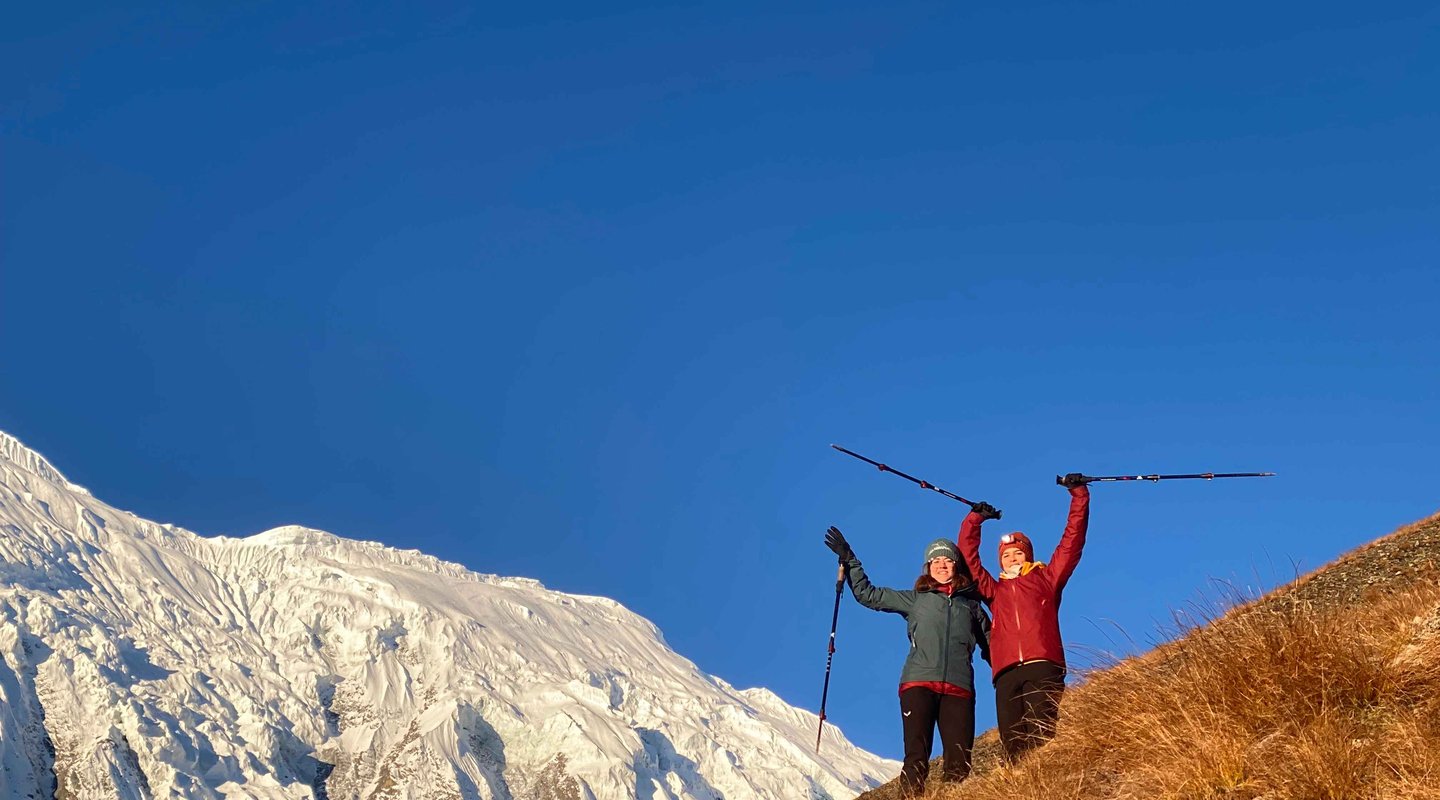Introduction
If you plan to go for the Annapurna Circuit Trek, you must be well equipped with appropriate clothes and gear. It takes proper planning to pack the right things and not overpack. But don’t you worry about it as we are here to help you with the thorough guide on what you should be packing and clearing your queries from What to wear for Annapurna Circuit Trek to Annapurna Circuit gear list so that you do not fall short on anything as you have already embarked on the journey to Annapurna Circuit.
This is a comprehensive guide for your packing checklist for the Annapurna Circuit Trek, considering the varying altitudes, diverse terrains, and climatic conditions to make you take only the quality equipment and not overburden yourself with unnecessary things. This is gonna be the ultimate packing checklist for the Annapurna Circuit Trek for you.
Understanding Annapurna Circuit Packing Needs: Key Considerations
Climate Variation & Layering Strategy
Annapurna Circuit Trek features various climatic conditions because of the varying altitudes and diverse geographical features. The Annapurna Sarakhi track will make you go through different kinds of temperatures, such as temperate climate in the lower elevations, and as you ascend higher, you will experience the temperate climate and the alpine climate above 4,000 metres. When you cross Thorong La Pass (5,416 m/ 17,769 ft), the temperature will drop to around -10°C (14°F) C. so So, you need to have a layering strategy with your Annapurna Circuit clothing layers to adapt to these varied climatic conditions to tick off your packing checklist for the Annapurna Circuit Trek.
For Annapurna Circuit clothing layers, you will be using the layering strategy of three distinct layers, which is a combination of base layers, mid layers, and outer layers to ensure protection from the diverse climatic conditions. For this, you will need to pack lightweight and moisture-wicking clothes to keep your body temperature, windproof and waterproof clothes to make sure you protect yourself from the rain and wind, and warm clothes such as fleece jackets or down jackets for cold temperatures.
Annapurna Circuit trek has a lots of things to offer on its journey, in which its cultural highlights will make you worth doing it.
Duration of Trek & Porter Use
You will typically take 15 to 18 days to complete the Annapurna Circuit Trek, but it also depends on your chosen route, fitness level, and pace of the trek. You will be crossing Thorong La Pass (5,416 m/ 17,769 ft) while the Annapurna Circuit Trek will cover from around 160 to 230 kilometres. The route is very challenging with the diverse terrains featuring the steep ascents, high altitude passes, and flat areas. So, we recommend that you hire a guide who is easily available for your service.
A porter will carry 15 to 25 kgs of weight, including the Annapurna Circuit gear list, and this can allow you to trek quite smoothly by taking in the whole stunning landscape and towering peaks around you. The porter will help you in reducing your load, but you also need to be mindful of your Annapurna Circuit backpack size and be considerate while ticking off your packing list for the Annapurna Circuit Trek.
Personal Preferences & Comfort
You can significantly enhance your trekking experience as you choose to function with your personal preferences and comfort. So, while ticking off your packing checklist for the Annapurna Circuit Trek, choose the right pairs of footwear, such as comfortable Annapurna Circuit trekking boots, which are fit for rugged terrains. Additionally, you must go for Annapurna Circuit clothing layers that are breathable, lightweight, and warm, and thicker.
Even with your food preferences, take those food items that comfort you and take the comforting personal hygiene products for Annapurna Circuit toiletries, such as wet wipes and biodegradable soap. More importantly, take Annapurna Circuit water purification tablets as hydrating yourself throughout the exhausting trek is crucial, so you can use them to purify the water you find to drink along the trails. So, customize your packing list for the Annapurna Circuit Trek according to your personal preferences and comfort to be at ease and for more enjoyment. Also, read our complete guide to know the best time to do the Annapurna Circuit Trek.
Comprehensive Annapurna Circuit Packing List
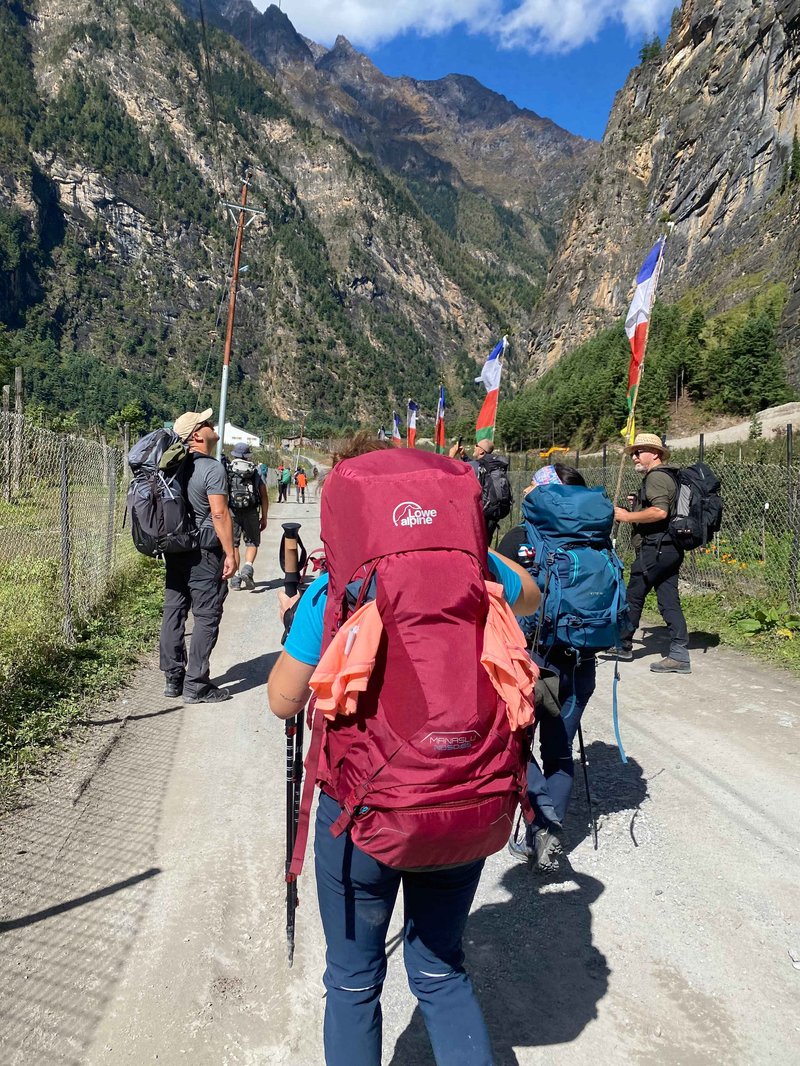
Clothing: The Art of Layering
Your query about what to wear for the Annapurna Circuit Trek will be cleared with the following guidelines for Annapurna Circuit clothing layers.
Base Layers
Base layers are the first defense against the harsh temperatures of and as the first layers of Annapurna Circuit clothing. They are crucial for keeping you dry during your strenuous hikes, so they must make it to your packing checklist for the Annapurna Circuit Trek.
Synthetic fabric: For the base layers, you should go for the synthetic fabrics such as polyester and nylon as they are the best in moisture wicking and are affordable too. They are quick to dry, so they will keep you dry throughout your high-intensity hikes.
Merino wool fabric: As for merino wool fabric, which is also one of the options for base layers, they are soft and regulates your body temperature. They are basically the warmth retainer, keeping you warm in cold weather.
Therefore, you should choose the base layers that are a snug fit (not so tight), breathable, lightweight, and seamless to avoid maximum chafing.
Note: Synthetic fabrics can give you an odour if used for a long time.
Mid Layers
Mid layers are crucial and must make it to your Annapurna Circuit clothing layers. You can choose the popular choices for mid layers, which are fleece and insulated jackets, which will not only protect you from the harsh weather conditions but also provide you the insulation for maintaining warmth.
Fleece jacket: You should choose fleece jackets with a zip-up design allowing for ventilation, with the characteristics of lightweight and breathable ones. They should be durable and quick to dry as well.
Insulated jacket: You should choose insulated jackets that are water-resistant and function well in harsh weather conditions. They are crucial, as even when you are wet, they will retain warmth, so it is critical to have them in rain and snow. So, consider choosing the ones that are compressible to give you space in your Annapurna Circuit backpack size.
Outer Layers
Outer layers, as part of your Annapurna Circuit clothing layers, must make it to your packing checklist for the Annapurna Circuit Trek. They will protect you against the cold temperatures and unpredictable weather conditions.
Down jacket: You can choose down jackets as outer layers as they are excellent in providing you warmth, and they do not possess significant bulk, perfect for your Annapurna Circuit backpack size. While choosing down jackets, look for waterproof ones so that they can keep you dry even in damp conditions during your trek.
Waterproof/ Windproof Shell: You must take a windproof or waterproof shell to protect yourself against rain, wind, and snow. So, choose the breathable ones that have adjustable cuffs as well, and make sure that they keep you dry.
Trekking Pants & Shorts
Trekking Pants: Trekking pants are your workhorses during the trek so it should make it to your packing list for the Annapurna Circuit Trek. You should look for merino wool fabric and the ones that are durable, lightweight, and most importantly, comfortable and moisture-wicking. The best you can choose are the convertible pants as they have zip-off legs, which you can convert the pants to shorts according to the temperatures for your ease.
Shorts: Shorts are the best alternative for long trekking pants in warmer temperatures. You should look for breathable and moisture-wicking characteristics to avoid chafing, and also look for the ones that will give you good stretch and mobility along the trek.
Underwear & Socks
Underwear: You should take seamless, designed underwear made of synthetic or merino wool fabric to avoid skin irritation and chafing during the long walking durations. Pack enough underwear as the laundry service might not be available everywhere, and it might be quite difficult to get it dry in the cold elevations, so look for the quick-drying ones.
Hiking Socks: You will need hiking socks, especially during the high ascents. You should take moisture-wicking socks to keep your feet dry even in wet conditions, and thick and warm socks to protect from the cold. Also, look for the ankle coverage to avoid blisters and debris from your legs. Thermal socks will be the best for the higher temperatures to provide you with extra warmth, and they are breathable too.
Non-Trekking Socks: You can wear non-trekking socks at tea houses for relaxation, as they are not for the hikes.
Note: Pack enough pairs of socks to change into during the damp and sweaty days.
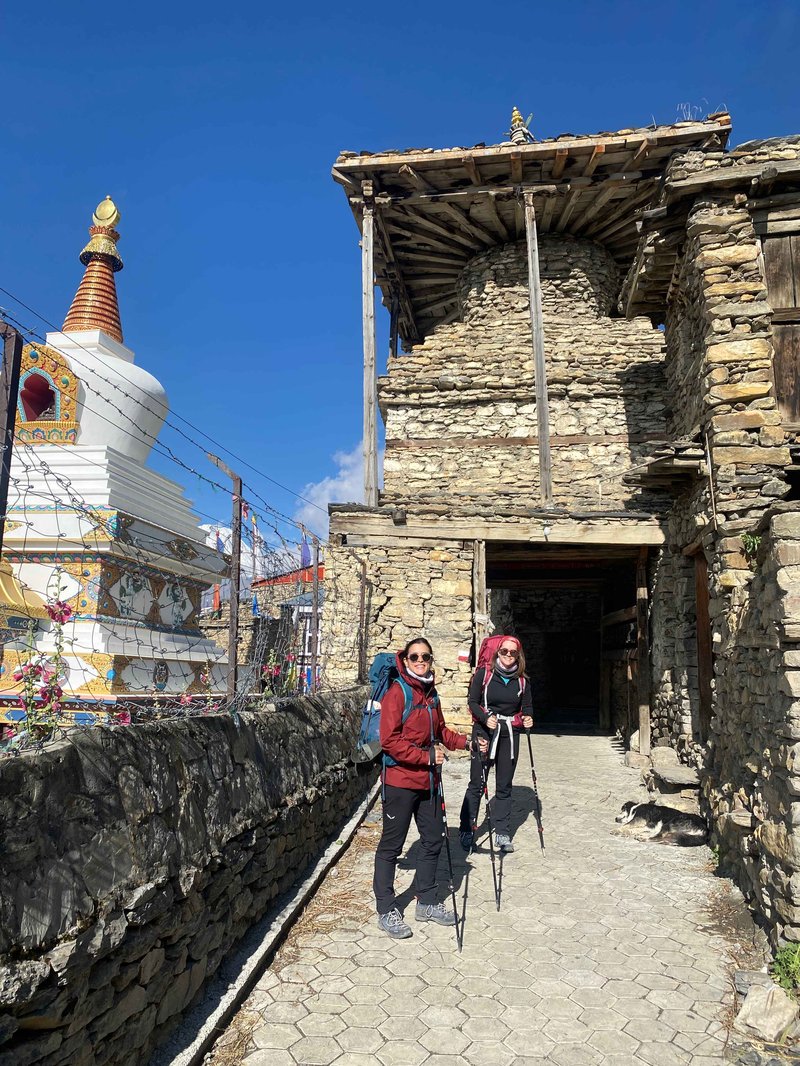
Headwear & Gloves
You must select the right headwear and gloves for your packing list for the Annapurna Circuit Trek to protect yourself from the cold and harsh weather conditions.
Warm hat: You will need a warm hat in the cold high altitudes. You should look for fleece or wool fabric to keep your head warm during the coldest conditions, and make sure that they are lightweight.
Sun Hat: You should take a wide-brimmed hat to protect your face and neck from the sun when the heat is intense.
Buff: You can use a buff for multiple purposes as they can protect your neck from the sun and cold but also can be used to cover your face for protection in windy conditions.
Liner: Liner gloves are thin and are moisture-wicking to provide you with insulation, and these are worn in moderate temperatures. You can wear them under your thicker outer gloves to keep yourself warm during freezing conditions.
Outer Gloves: You must choose waterproof outer gloves to protect yourself from the rain and snow. Also, make sure they have good gripping material to enhance your functionality with using trekking poles.
Teahouse Wear
Comfortable Pants: After a long day hike, you will need comfortable pants to wear at the tea house for relaxation and comfort. Even while sleeping, you will feel comfortable in such comforting pants rather than hiking pants. So, look out for the zippered pockets to keep phones and elastic waistbands.
Flip-flops: We recommend that you take flip-flops to wear at tea houses for your foot comfort. Look out for the cushioned soles that have adequate arch support. You can choose the one with a sturdy rubber outsole, which is good for wet days.
- Footwear: Your Foundation for the Trek
Hiking Boots
You need to have well-broken hiking boots that you can wear on multiple shorter hikes. You can have discomfort and injury over long walking durations if your boots are not well broken in. You should get waterproof hiking boots, which will keep your feet warm and dry and give you good ankle support as well on the uneven ground. This definitely should make it to your packing list for the Annapurna Circuit Trek.
Trail Runners/Sandals
You must take trail runners, which are lightweight, breathable, and help you to prevent getting blisters by keeping your feet dry, and are different from trekking boots. Look for the one that has good traction for slippery and uneven surfaces.
You will need sandals to wear at the tea houses for your comfort. So, you should look for the one that has comfortable straps and supportive footbeds.
Socks
You should get moisture-wicking socks to keep your feet dry. It is best if you avoid cotton fabric socks to reduce getting blisters, as they retain moisture. You should look for the padding, as it prevents the formation of blisters as well.
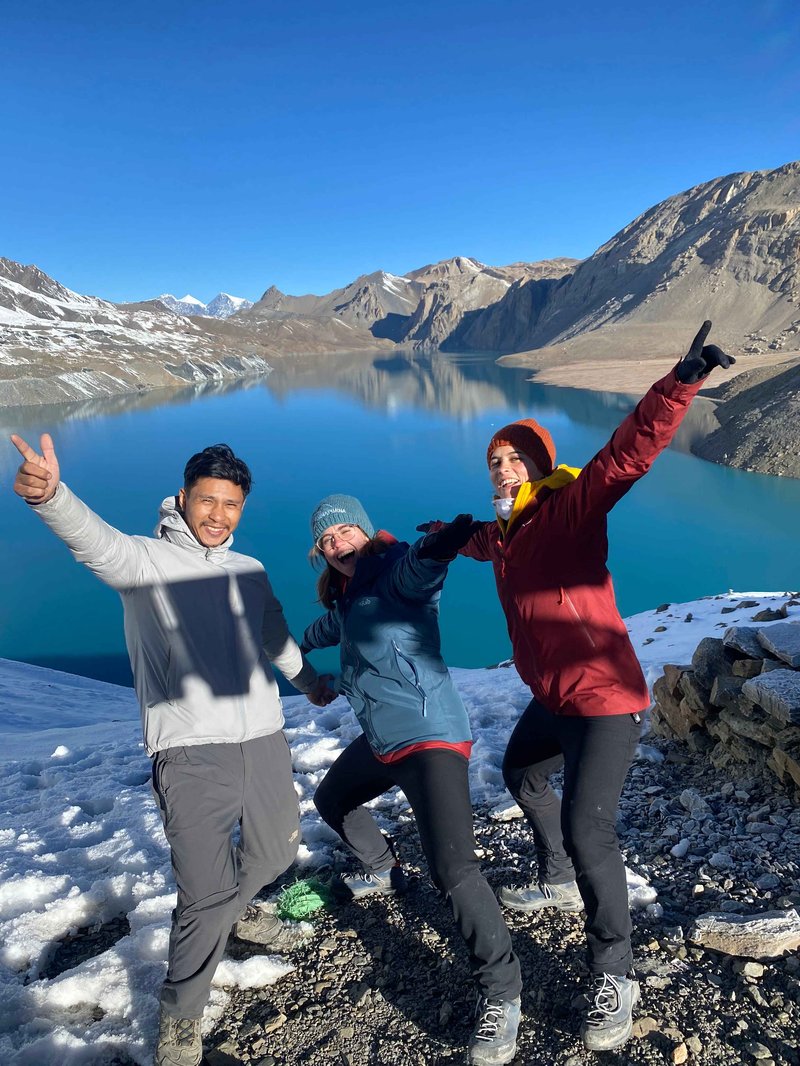
- Essential Gear & Accessories
Backpacks
Backpacks are crucial for your packing checklist for the Annapurna Circuit Trek. You should look for a backpack as main luggage that has the capacity of 50-60 litres, which will give you enough space for your clothes, gear, and other essentials. You should choose a waterproof and durable backpack with multiple compartments.
Additionally, you need a day pack that has a capacity of 20-30 litres. This daypack will carry your essentials such as personal items, clothes, snacks, and water during your short hikes. Most importantly, it should have a rain cover to protect your essentials, especially the gear, from the rain and moisture to not get rusty.
Sleeping Bag
A sleeping bag must make it to your packing checklist for the Annapurna Circuit Trek. You must choose your Annapurna Circuit sleeping bag temperature rating -10°C to -20°C. Sleeping bags with -10°C will protect you in the milder conditions, and -20°C will protect you from chilling cold at higher elevations, especially at Thorong La Pass (5,416 m/ 17,769 ft). You should look for the draft collar design and well-sealed zippers.
Trekking Poles
Trekking Poles should make it to your packing list for the Annapurna Circuit Trek. These will provide you with stability and balance during your long walking hours. As they distribute your body weight, there will be less strain on your knees even during your descents. So, choose the one that is comfortable in grip as well.
Headlamp with Extra Batteries
You will need a headlamp during your nighttime teks. It will allow you to have free hand movements, so go for the one that has an LED light, as it provides the facility of charging fast and gives longer lighting time. You need to take extra batteries as it can be life-saving, and go for rechargeable batteries or a solar charger for sustainable trekking to avoid waste.
Water Bottles/Hydration Bladder & Purification
You should carry a water bottle or hydration bladder with the hands-free sipping feature through a tube. As you get the water from the streams and rivers along the trails, it is safer to drink the water after using water purification tablets or filters. So, you need to carry the Annapurna Circuit water purification tablets.
Sunglasses
The sun’s intensity increases at higher altitudes, and the snow reflects a lot of glare. So, you must use Polarized sunglasses that will reduce the glare, and the wrap-around design protects you as it minimizes the sunlight exposure from the sides.
Travel Towel
Travel towel made from microfiber must make it to your packing checklist for the Annapurna Circuit Trek. This towel is lightweight and has a high moisture-absorbing feature. Microfiber is soft, reducing skin irritation, and has the qualities of quick drying.
- Health & Safety Kit
Personal First Aid Kit
A first aid kit is crucial for treating minor injuries and illnesses, so you must include it to the packing checklist for the Annapurna Circuit Trek. Your Annapurna Circuit first aid kit should include all the essential medications. You are most likely to get Altitude Mountain Sickness (AMS) at high altitudes, so you need to take medications such as Acetazolamide to prevent it. Additionally, you can take pain relievers such as Paracetamol and Ibuprofen. For blisters, which are common to get because of the long walking durations, you should take adhesive bandages, antiseptic wipes, and a moleskine to prevent your blisters even worse.
Sunscreen & Lip Balm (High SPF)
At higher altitudes, you will be exposed to more UV radiation. So, you need to protect your skin on your face, hands, neck, etc, for which you must take a sunscreen that has SPF 30 at least. Additionally, you will get really dry lips and sunburn, so you must take a lip balm which has SPF 15 to protect your lips from sunburn and from getting chapped. So, make it a part of your Annapurna Circuit toiletries.
Hand Sanitizer & Toilet Paper
Personal hygiene is crucial during the trek as you will be exposed to a lot of dirt and dust. So, you should take travel-sized Annapurna Circuit toiletries such as hand sanitizer and toilet paper. You can use hand sanitizer to maintain sanitation after meals and after using public facilities where you are limited with water and soap. You should take a biodegradable soap for environmental sustainability, which is crucial for the Annapurna region. You can also check out our article on eco-friendly trekking tips. Additionally, you must take enough toilet paper to ensure you are maintained with hygiene along the trails, which have limited toilet facilities.
Personal Medications
You need to take your personally prescribed medications to keep your health in good condition throughout the Annapurna Circuit Trek. You must take your regular medications if you have any chronic conditions like asthma, hypertension, diabetes, etc. Also, we recommend that you consult your health professional to guide you with the medications, as you may need other medications depending on the change in altitude. Additionally, you need electrolyte supplements such as electrolyte powders and tablets to ensure you are hydrating and replenishing yourself with the minerals that you lose through sweating.
- Documents & Money
You should not forget to include your documents and money in your packing checklist for the Annapurna Circuit Trek.
Passport: You need to make sure that your passport has validity of at least 6 months after your intended stay ends in Nepal.
Visa: You can get your visa after you arrive at Tribhuvan International Airport in Nepal, or you can obtain it with the help of the embassy. You can extend your visa for a minimum of 15 days, which will cost 4 USD per day. You can visit the official website of the Nepali Department of Immigration for more information regarding the process of visa and its cost.
- 15 Days Travel Visa: USD 30
- 30 Days Travel Visa: USD 50
- 90 Days Travel Visa: USD 125
Permits: You are required to get two permits; without them, you are not allowed to get into the Annapurna Circuit Trek. You can obtain these two cards from the Nepal Tourism Board Office in Kathmandu.
- Annapurna Conservation Area Project (ACAP) Permit: You will need this permit when you trek through the Annapurna Conservation Area. This permit will cost you approximately 30 USD.
- Trekker’s Information Management System (TIMS) Card: The TIMS card is for your safety as it keeps track of your transit points. It will cost you around 20 USD.
Travel Insurance Documents
You are required to have Travel Insurance to apply for the permits. We highly recommend that you get travel insurance that covers your medical facilities, including the helicopter evacuation. You can get less financial burden if you encounter any costly medical facilities.
Nepali Rupees
You need to have the local currency, Nepali Rupees, to cover your expenses. Although you might get some ATMs in the lower regions, which are less reliable. You must carry enough Nepali rupees, even if your food and accommodation are covered in the package by the trekking agency. If you have cash, you will have fewer issues during the Annapurna Circuit Trek. But make sure to keep it safe during your stay at the hotels and tea houses of the Annapurna region. You can check our article on how to enhance your safety during the Annapurna Circuit Trek. interlink
- Electronics & Entertainment
Camera & Extra Batteries/Lenses
You will not miss out on the camera for the Annapurna Circuit electronics packing. You should take a camera that has versatile lenses that can capture wide panoramic views and locals with standard zooming features. Also, you should take extra batteries because you will lose them batteries quite quickly due to cold temperatures.
Power Bank/Portable Charger
Power bank and portable charger must make it to your Annapurna Circuit electronics packing. You will have limited electric outlets, and your electronic devices need to be charged for your communication, navigation, and safety. So, you must take a power bank that has a high capacity to charge multiple electronic devices and must make it to your packing checklist for the Annapurna Circuit Trek.
Phone & Local SIM Card
You need to bring your phone and buy a local SIM card after arriving in Nepal for your own safety, to keep in contact. The most common SIM cards are ‘Namaste’ and ‘Ncell,’ and both of the SIM cards offer wide coverage in the Annapurna region. You can buy these SIM cards in Pokhara and Kathmandu.
E-Reader/Book
You can overcome your downtime or physical exertion with reading books, or you can also opt for E-readers such as Kindle or Kobo, which have thousands of books stored and are lightweight and compact as well. But make sure you protect it using a waterproof bag from dirt, dust, and moisture.
- Optional but Recommended Items
Knee Brace: You can take knee braces with you if you have a history of issues with your knees. If you want to prevent more strain on your knees, especially while descending or if you feel any knee pain during the Annapurna Circuit Trek, you can use them. So, it is an optional item for the packing checklist for the Annapurna Circuit Trek.
Gaiters: Gaiters are optional, but they can protect your legs from mud, debris, and prickly thorn plants, bushes, and insects during the rugged trails.
Snacks (from Kathmandu): You can buy snacks in Kathmandu, as the prices in the Himalayas are higher. So, if you want to take snacks for your trek, you can buy those from Thamel, which offers a variety of snack products.
Packing Tips for a Lighter Load
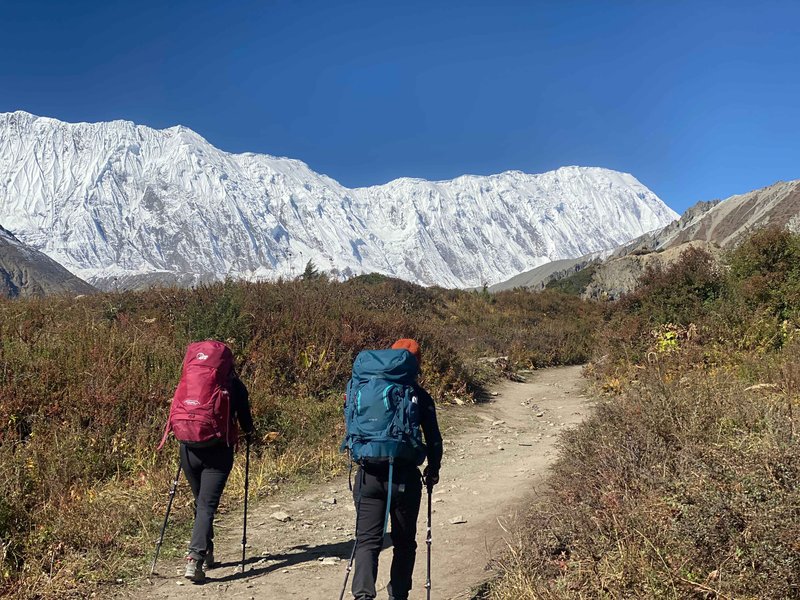
Prioritizing Essentials & Avoiding Overpacking
You need to focus on your Annapurna Circuit gear list and packing strategy to reduce your Annapurna Circuit backpack size.
Firstly, you need to understand the terrain and duration of the Annapurna Circuit Trek. You should remove the unnecessary items or the things that you think may not be needed, this will lighten your load significantly. You can opt to use a backpack that is designed for trekking, which is lighter and has more space for your Annapurna Circuit gear list. You should make your Annapurna Circuit backpack size around 10-15% of your body weight to make it balanced. This will prevent you from losing a lot of energy, making you fatigued. You can use compression sacks to minimize your space in your backpack.
Then, you need to go for lightweight and only the high-quality gear that will come in need. For this, you can take Annapurna Circuit trekking boots that support you and are comfortable for long walking durations. You need to take Annapurna Circuit clothing layers as moisture-wicking base layers, insulating layers, and waterproof outer layers. You should bring washing materials to wash your clothes rather than carrying unwanted extra clothes. This will lighten your load.
Most importantly, make a final list of the essentials and remove anything that you find unnecessary. This way, you should prioritize your essentials and avoid overpacking.
Utilizing Porter's Effectively (10-15kg limit)
If you are restricted to a weight of 10 to 15 kg. Then, you should take only the essential gear that is lightweight and compressible, which will also lighten the burden for your porter. If there is more than one porter, then you should distribute your load evenly for the porters. One more effective thing you can do is talk to the porters and understand their capacity, and always try to hire the ones who belong to the region, for their good knowledge about the trails. This way, you will be contributing to the local economy as well.
Buying vs. Renting Gear
You can either buy or take gear on rent according to your preferences. Buying gear is a good investment if you are a frequent hiker. Additionally, your gear will be according to your needs, preferences, and body measurements. So, buying can be beneficial for longer use. Although they can be expensive and just a waste of money if they are bought for a one-time hike.
On the other hand, you can get gear on rent in Kathmandu and Pokhara. Renting can be advantageous for you if you are tight on your budget and if you are just an occasional trekker. Although they may not meet your preferences, you should consider the conditions of the gear, as they may be in a worn and torn condition.
Therefore, you must evaluate your Annapurna Circuit gear list. For that, you can take lighter sleeping bags and other essentials to balance your load. You need to choose the gear wisely according to their weight, quality, and convenience, whether you buy or take them on rent.
Please feel free to contact us at [email protected] or WhatsApp us at +9779801127073.
You can book our Annapurna circuit trek package here
annapurna-circuit-trek-14-days-himalayan-hero-adventure

